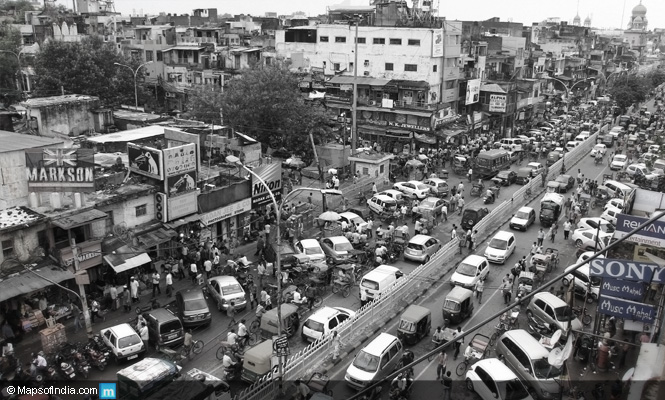Well, one of the most common and irritating problems that one faces in the national Capital of our country is getting caught in traffic jams. The daily commuting on the roads of Delhi is becoming longer and more gruelling day by day, depicting the failure of public transportation infrastructure to keep pace with the growing developing activities in the Capital. Sad, but true, one of the fastest growing and developed cities of the world, Delhi, is also renowned for all the wrong reasons. According to a report made by IBM’s global Commuter Pain study in 2013, New Delhi is among the top 10 cities in the world having the worst traffic jams. Really, the worsening traffic congestion on Delhi roads presents a depressing profile of the Capital city.
Some of the major causes of traffic congestion in Delhi
- Substantial increase in the number of vehicles on Delhi roads in recent years. In fact, studies have shown more than a lakh vehicles are plying almost every day on most of the important corridors in Delhi.
- The road length in Delhi has increased at the rate of 4.53% per year, which, of course, is not in pace with the growing population. It is reported that the road density in Delhi is around 155 km per 100,000 population and about 80 vehicles per km.
- At the intersections, the cycle time ranges from 120 to 180 seconds, which leads to long queues, especially in the peak hours.
- Another major cause is that Delhi roads are characterised by mixed traffic, which include, personal vehicles, buses, trucks, three-wheelers, two-wheelers, including animal-driven carts and pedestrians. This creates problems for traffic management and leads to delays in movement of the traffic.
- Increase in the growth of the population in Delhi, which includes the growing number of workforce, is another important cause.
- There has been inadequate public transport system in Delhi. In spite of metro and bus services, the transport system is not being able to keep pace with the growing population, as a result of which, more and more people use their private vehicles, leading to increased congestion on the roads.
- Last, but not the least, ongoing construction of Metro network in various locations, damaged roads, repairing roads all contribute to severe traffic congestion in the city.
Outcomes
- No doubt, traffic congestion is resulting into unnecessary delays and reduction in speed.
- It has resulted into a non-productive activity for most people as when they get stuck in traffic jams, they reach their workplace late or reach back home late.
- It has resulted into high rate of road traffic fatalities, making travelling and driving very unsafe in Delhi.
- Traffic congestion has also led to an increase in the number of accidents on the roads. In fact, Delhi has the highest accident rate in India and third-highest in the world.
- Here, the irony is that everyone is in a hurry but nobody reaches on time.
- Traffic rules, red lights, lane driving are not followed which are both the causes and effects of traffic congestion in Delhi.
- Inability to forecast travel time accurately.
- Fuel wastage.
- Increasing air and noise pollution.
- Wear and tear on vehicles.
- Increased road rage.
- Blocked traffic also interferes with the passage of emergency vehicles etc.
Role of Government in controlling traffic in Delhi
To improve the quality of public transport, some measures taken by the Government are:
- Completion of second phase of Delhi Metro has provided a convenient public transport system to the commuters of Delhi and the adjoining NCR cities of Gurgaon, Noida and Ghaziabad.
- More than 3,500 low floor air-conditioned and non-airconditioned buses, including corporate sector buses, have been introduced by the Delhi Transport Corporation (DTC).
- Withdrawal of blue-line buses.
- Construction of new roads, foot bridges, flyovers and widening of existing road network
- A Delhi Transport Infrastructure Development Corporation has been set up to manage Inter- State Bus Terminals in Delhi.
- Ring Road bypass and elevated corridors in some areas of Delhi like Barrapula drain have been provided with signal-free flow of traffic.
Intelligent Transport System (ITS) and Delhi Integrated Multi-Modal Transit System Ltd. (DIMTS)
The main objective of DIMTS is to provide safe, accessible, reliable, sustainable and user-friendly public transport for commuters and set up a mechanism to deliver public transport service that keeps pace with growth. The problem of traffic on the roads of Delhi can be solved with the implementation of Intelligent Transport System (ITS) in a proper manner, as adopted by DIMTS. ITS in Delhi, for that matter, the whole of India, can bring about a sustainable and balanced transportation solution. It is basically the use of computer and communications technologies in the resolution of transport problems. It can help in timely gathering of data or intelligence and then providing feedback to traffic managers and road-users. Implementation of ITS can lead to reduced traffic congestion, better traffic efficiency, better safety to drivers, improved energy efficiency and increased economic productivity. Some examples of ITS include:
- Advanced Traffic Management Systems
- Advanced Vehicle Control Systems
- Advanced Traveller Information Systems
- Electronic Toll Collection Systems
- Advanced Public Transportation Systems
- Wireless Traffic Signal Controller
- Red Light-Stop Line Violation & Detection System
- CCTV Junction Surveillance
- Variable Message Sign
- Video Incident Detection etc.
This has already been adopted in other countries for effective management of traffic. In Delhi, it has started only recently. Proper implementation of ITS will definitely improve the scenario.
What other measures can be taken?
Some immediate steps that need to be taken by the Government to allow traffic to move somewhat safely in Delhi are as follow:
- Designing a well-maintained and well-developed public transport system.
- Designing separate roads or lanes to control speeds and vehicles of different sizes, weights and velocities.
- Promoting traffic safety and traffic rules through education, advertising and strict enforcement.
- Improvements in vehicle design.
- Strict enforcement of travel demand management and policies to be adopted to reduce the use of private vehicles.
- Ensuring safety and convenience to commuters of public transport and pedestrians.
- Introduction of cost-effective, environment-friendly and efficient new modes of public transport for congested lanes, streets and feeder system for major public transport.
- Last but not the least, encouraging walking and bicycling.
The effectiveness of such measures depends to a great extent on us, the public, the road users, the police and, of course, proper enforcement of the laws.
Read more:
Vehicular Pollution in Delhi and Its Impact on Lotus Temple
Traffic Signs and Road Safety in India
Worst road accidents in India
Will Tram Solve the Old Delhi Traffic Congestion
First-ever Tram Services to Begin in Greater Noida
Stop! Says The Red Light
Road Rage in Delhi: Keep Your Cool, Avoid the
anti-Socials
India’s Tourism Sector: Achievements and the Road Ahead
How to keep yourself entertained during long road trips?
Agra-Lucknow Expressway: India’s First Road Runway
List of Major Rail Accidents in india






